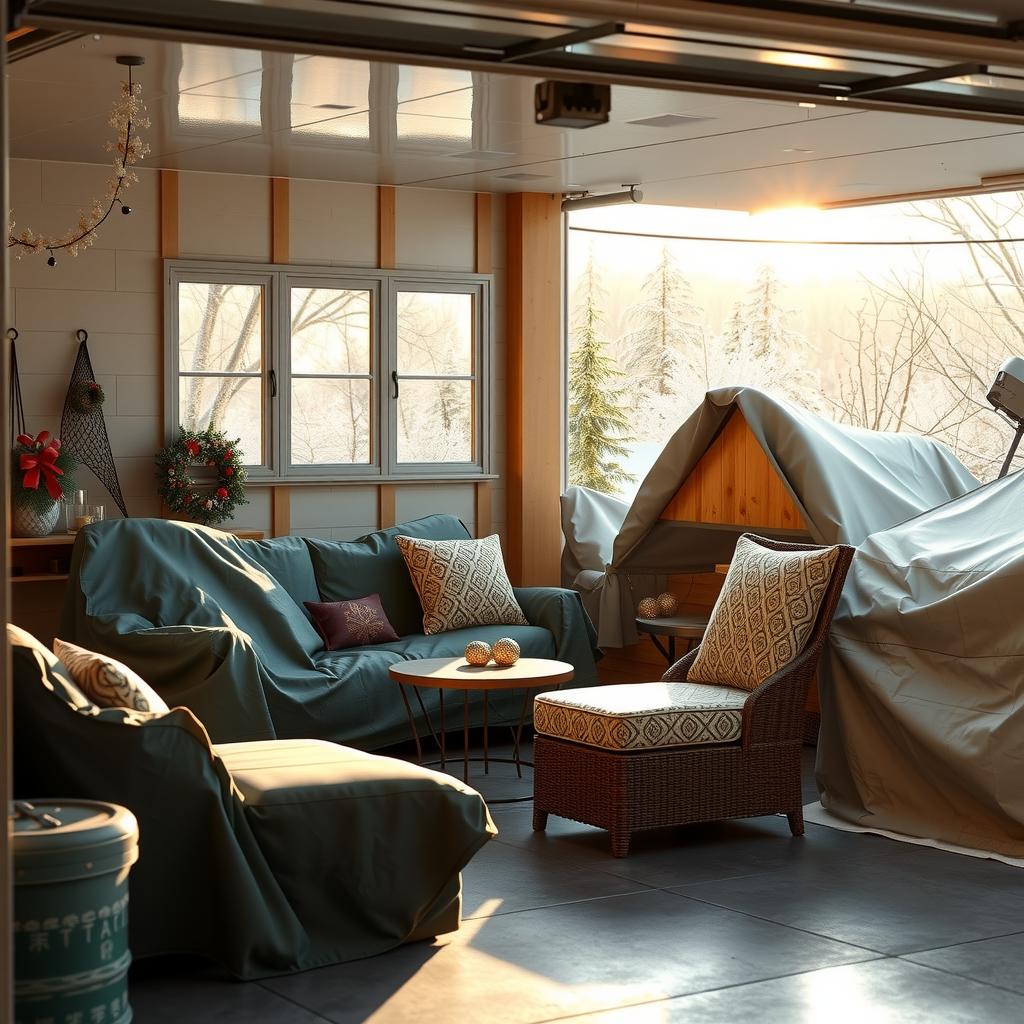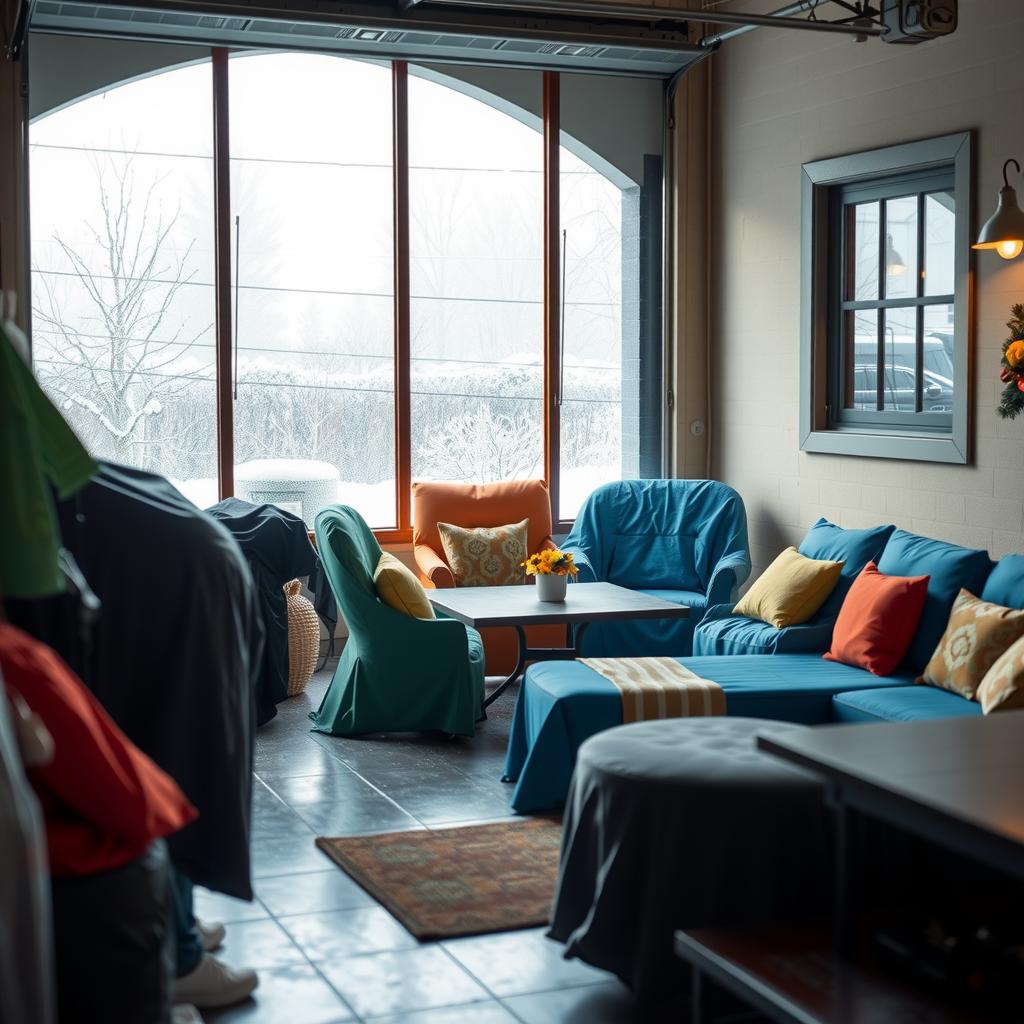As the leaves change color and temperatures begin to drop, many homeowners find themselves facing a familiar dilemma: what to do with their outdoor furniture. With winter on the horizon, proper winter storage is essential for preserving the beauty and functionality of those cherished pieces. Neglecting this crucial step can lead to damaged cushions, rusted metal frames, or splintered wood—transforming beloved outdoor decor into mere remnants by springtime. So how can one ensure that their investment in quality outdoor furniture withstands the harsh elements of winter?
This article delves into practical storage tips designed specifically for seasonal maintenance of outdoor furnishings. The core value lies not only in preserving aesthetics but also in extending the lifespan of each item through effective care practices. Readers will discover various strategies that cater to different types of materials—from resilient metals to delicate wicker—and learn about optimal protection methods tailored to local climates.
Whether it’s utilizing protective covers or choosing appropriate indoor spaces for storage, understanding these aspects can make all the difference when spring arrives and it’s time to unveil your garden oasis once again. This guide promises insights into efficient preservation techniques that keep furniture looking pristine while safeguarding against snow, rain, and ice.
By following these expert recommendations on furniture care, individuals can enjoy peace of mind knowing they’ve taken proactive steps towards maintaining their outdoor investments throughout winter months. Transitioning now into detailed strategies, readers are encouraged to explore how simple actions today may yield beautiful results tomorrow—not just for themselves but also for future gatherings under sunny skies!

Key Points:
-
Thorough Cleaning Before Storage: Ensuring that outdoor furniture is clean before winter storage is vital for its longevity. Dirt, debris, and moisture can lead to mold or rust if left unattended. Homeowners should take the time to wash each piece properly using suitable cleaning agents tailored for the material—be it wood, metal, or plastic. This practice not only enhances the appearance of outdoor decor but also provides a protective layer against winter elements.
-
Choosing Suitable Storage Locations: The location chosen for winter storage plays a crucial role in protecting outdoor furniture from severe weather conditions. Ideally, items should be stored in a climate-controlled environment that shields them from extreme temperatures and humidity fluctuations. If indoor space is limited, investing in high-quality protective covers can serve as an additional barrier against snow accumulation and ice damage during the cold months.
-
Utilizing Protective Covers: One of the most effective strategies for maintaining outdoor furniture throughout winter involves employing specialized protective covers designed specifically for various types of materials. These covers not only prevent fading caused by sun exposure but also guard against moisture buildup which can lead to deterioration over time. By incorporating these preservation methods into their seasonal maintenance routine, homeowners can ensure their cherished pieces remain intact and ready for use when warmer weather returns.

Essential Steps for Outdoor Furniture Care During Winter
Protecting Your Investment: Preparing for Seasonal Changes
As winter approaches, the importance of preparing outdoor furniture becomes paramount to ensure its longevity and durability against harsh weather conditions. The first step in this furniture care process is thorough cleaning. Accumulated dirt, leaves, and debris can lead to deterioration if left unattended during the cold months. A gentle soap solution paired with a soft brush is ideal for removing grime without causing damage to the surface finishes of various materials such as wood or metal. After cleaning, it’s crucial to rinse thoroughly and allow ample drying time before storage.
Choosing the Right Storage Environment
Once your outdoor decor pieces are clean, selecting an appropriate storage location is essential for maintaining their condition throughout winter. Ideally, they should be stored in a dry space that protects them from moisture accumulation—such as a garage or shed—to minimize exposure to rain and snow. Weather protection measures are also beneficial; using breathable covers can shield furniture from dust while allowing air circulation to prevent mold growth.
Preservation Methods: Enhancing Durability
To further enhance durability during winter storage, applying protective treatments tailored to specific materials can yield significant benefits. For wooden furniture, consider using specialized oils or sealants that penetrate deep into the grain—this acts as a barrier against moisture penetration and cracking due to freezing temperatures. Metal items may require rust-proof coatings or sprays designed specifically for outdoor use; these will help deter corrosion caused by humidity changes common in colder climates.
Seasonal Maintenance Tips
In addition to proper cleaning and treatment methods prior to creating an effective winter storage strategy, regular checks on stored items can alert owners of any developing issues early on. Even after careful preparation steps have been taken initially at season’s end—periodic inspections will ascertain whether any condensation has formed under covers or if pests have made themselves comfortable within your cherished pieces.
Revitalizing Your Space Come Springtime
When spring arrives again after months of hibernation indoors tucked safely away, reviving outdoor spaces begins with unveiling those well-preserved treasures! A quick once-over with mild detergent will remove any dust accumulated during inactivity followed by reapplying oil treatments where necessary ensures everything looks fresh—and ready—to enjoy when warmer days beckon back outside over vibrant gardens filled full bloom flowers! By investing effort now into seasonal maintenance, individuals ultimately safeguard not only aesthetics but prolong functional life too—all contributing toward delightful gatherings around beautifully maintained patios year after year!
Tailoring Storage Techniques for Different Types of Outdoor Furniture
Effective Care Tips for Wood, Metal, and Plastic
When it comes to protecting outdoor furniture during the winter months, understanding the distinct care requirements of different materials is essential. Wooden outdoor furniture demands special attention due to its susceptibility to moisture and temperature fluctuations. To ensure longevity, it is advisable to clean wooden pieces thoroughly before storage; using a gentle soap solution can remove dirt and debris while preventing damage. Once dry, applying a protective sealant or oil helps in maintaining the wood’s natural luster and offers an additional layer against water ingress. For optimal preservation methods, storing wooden furniture in a climate-controlled environment can significantly minimize warping or cracking caused by extreme cold.
In contrast, metal outdoor furniture, commonly made from aluminum or wrought iron, requires less intensive upkeep but still benefits from proper maintenance practices. Before stowing away metal pieces for winter storage, they should be scrubbed down with soapy water to eliminate any rust-causing grime. It is crucial then to dry them completely as moisture can lead to corrosion when stored away for long periods. Additionally, applying a coat of rust-resistant paint at least once every few years acts as an effective barrier against weather elements during seasonal changes.
For plastic outdoor furniture, the approach differs slightly since this material tends not to absorb moisture like wood does; however, it still requires careful treatment regarding UV exposure that may cause fading over time. Simple cleaning with mild detergent followed by thorough rinsing will help avoid mildew buildup during off-seasons when items are left unattended outdoors. When considering winter storage options for plastic pieces—especially lightweight tables and chairs—a covered area free from direct sunlight is recommended if indoor space isn’t available; this prevents discoloration due to prolonged sun exposure while also providing protection against snow accumulation that could warp their structure.
Utilizing appropriate storage tips tailored specifically toward each type of material ensures that outdoor decor remains visually appealing and structurally sound throughout all seasons. By implementing these strategies consistently—as part of broader seasonal maintenance routines—furniture owners can extend the life span of their investments significantly while enjoying peace-of-mind knowing they’ve taken proactive steps towards preserving their beloved patio settings through colder months ahead.
Strategic Storage Solutions
Optimal Locations for Your Outdoor Decor
When it comes to ensuring the longevity of outdoor furniture, selecting the right storage environment is crucial. Understanding how climate affects various materials can aid in identifying optimal storage locations that provide necessary weather protection. For instance, a garage or a shed can serve as ideal spots for winter storage, protecting pieces from harsh elements like snow and ice that could lead to deterioration. Additionally, utilizing breathable covers or tarps during off-seasons helps maintain the integrity of outdoor decor while preventing moisture buildup. Proper ventilation is also essential; therefore, spaces that allow air circulation without exposing items directly to the elements are preferable.
Methods That Enhance Durability
Incorporating effective preservation methods into your seasonal maintenance routine can significantly enhance your outdoor decor’s durability. It is advisable to clean furniture thoroughly before storing it away. This process removes dirt and debris that could cause stains or mold growth over time. Following cleaning, applying suitable protective coatings specific to materials—such as wood oils or metal sealants—can offer an additional layer of defense against weather-related wear and tear. Maintaining an organized storage space not only facilitates easy access but also prevents accidental damage during retrieval seasons when families often bring out their favorite pieces again.
Tips for Effective Furniture Care
Implementing strategic storage tips extends beyond just finding a location; it’s about understanding how best to care for your items throughout their lifespan. During transitional periods between seasons, homeowners should perform regular checks on covered furniture within storage areas for any signs of mold or pest infestation—a proactive approach ensures ongoing protection while preserving aesthetics and functionality alike. Furthermore, rotating cushions and pillows regularly invites even wear across all surfaces rather than concentrating stress on one area alone; this small practice ultimately prolongs their usability as well as comfort levels when entertaining guests outdoors.
By focusing attention on both appropriate environments and careful preservation methods while employing thoughtful strategies in every stage—from winterizing processes through seasonal upkeep—individuals will find they can maximize enjoyment from their outdoor setups year-round without compromising quality or style.
Frequently Asked Questions:
Q: How should outdoor furniture be prepared for winter storage?
A: To effectively prepare outdoor furniture for winter storage, it is essential to start by cleaning all surfaces thoroughly. This helps remove dirt and debris that can cause damage over time. Once cleaned, consider applying a suitable protective finish if applicable, especially for wood pieces. Finally, choose a climate-controlled storage location or invest in high-quality covers designed specifically for your type of furniture to ensure adequate weather protection.
Q: What types of protective covers are best suited for outdoor decor during the winter?
A: When selecting protective covers for outdoor decor, it’s crucial to look for materials that are durable and water-resistant. Covers made from breathable fabrics help prevent moisture buildup while keeping snow and ice at bay. Additionally, specific designs tailored to different materials—such as those made from heavy-duty polyester or vinyl—can enhance the longevity of various types of furniture care during harsh weather conditions.
Q: Can I leave my metal outdoor furniture outside during winter?
A: Leaving metal outdoor furniture outside without proper precautions can lead to rust and corrosion due to snow accumulation or moisture exposure. For optimal results, it’s advisable to either bring these items indoors or adequately cover them with quality protective coverings designed for seasonal maintenance. Regularly inspecting any exposed areas will also help identify early signs of wear or damage before they become more significant issues as part of your overall winter storage strategy.